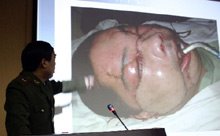The chinese transplant

1) It is more extensive (2/3 of face), that the carried out 6 months before, to the Frenchwoman: Isabelle Dinoire (38), to whom alone lips and nose were transplanted. To, Li Guozing (30 years, disfigured by a bear), have the surgeons transplanted extensive central parts of the face, upper lip, nose and eyelids, with what he will have a new face (neither the prior one, neither that of the donor). With it, the possibilities to establish youthful facies to old men or, new and unrecognizable faces to criminals, are open.
2) Beeing dominated the technique, it will happen certain unexpectedly new and various ethical problems. By the way, the British Trasplant Society, after showing http://news.bbc.co.uk/1/hi/world/asia-pacific/4921116.stm a growing number of evidences has accused publically to certain sectors of the Chinese government, of trafficking -to very high prices- thousands of body organs of prisoners and criminal. The most serious thing is that some prisoners were selected few weeks, before being executed.
3) That, this type of transplants, confronts risky complications, to know: a) facial massive blood thrombosis, on account of the infinity small blood vessels present in the facial skin, effect that can nullify the transplant, motivating the search of a new donor b) risk of refusal of the face transplanted, effect that can be present in the first 3 months, post surgery. To minimize this possibility the French surgeons carried out to I. Dinoire, a transplant of bone marrow, procedure not made to the Chinese patient. c) the pharmacological inmunosuppression, can condition certain forms of cancer, in the transplanted.
4) Being the risks (ethical, psychological, surgical), so various and high, we see us forced to think about other options or variant. The best : rescue stem cells of the face not affected of the own patient, be cultivated them and when have sufficient skin, proceed to perform face autotrasplants.
El transplante chino
Tras 14 horas de arduo trabajo, el jueves 13/04/2006, se realizó el segundo trasplante parcial de cara, en el Hospital Xijing (ubicado en Xi’an capital de la provincia de Shaanzi, área noroccidental de China). Que novedades y reflexiones nos trae, este segundo caso de cirugía plástica innovadora?
1) Se trata de un trasplante mas extenso (2/3 de cara), que el realizado 6 meses atrás, a la francesa Isabelle Dinoire (38), a quien solo le implantaron labios y nariz. A, Li Guozing (30 años, desfigurado por un oso), le han implantado 2 carrillos, labio superior, nariz y párpados, con lo que la suya será una nueva cara (ni la previa, ni la del donante). Con ello, las posibilidades de implantar facies juveniles a gerontes o, nuevas e irreconocibles caras a criminales, están abiertas.
2) Al dominarse la técnica, sobrevendrán con toda seguridad, nuevos y variados problemas éticos. Por lo pronto The British Trasplant Society, tras mostrar públicamente, un creciente número de evidencias ha acusado públicamente a ciertos sectores del gobierno chino, de traficar -a precios muy elevados- miles de órganos de prisioneros y criminales. Lo más grave es que algunos prisioneros fueron seleccionados pocas semanas, antes de ser ejecutados.
3) Que, este tipo de trasplantes, confronta posibles complicaciones riesgosas, a saber: a) trombosis sanguinea facial masiva, a causa de la infinidad de vasos sanguineos pequeños presentes en la piel facial, efecto que invalidaria el trasplante, motivando la búsqueda de un nuevo donante b) riesgo de rechazo de la cara trasplantada, efecto que puede presentarse en los primeros 3 meses, post cirugia. Para minimizar esta posibilidad los franceses le realizaron a I. Dinoire, un trasplante de médula ósea. Al paciente chino, nó. c) la inmunosupresión farmacológica, puede condicionar ciertas formas de cáncer, en el transplantado.
4) Siendo los riesgos (éticos, psicológicos, quirúrgicos), tan variados y altos, nos vemos forzados a pensar en otras opciones o variantes. Lo mejor, seria que se rescaten células madre de porciones no afectadas de la cara del propio paciente, se las cultive y cuando se tenga suficiente piel, se proceda a efectuar autotrasplantes.



.+Photo+Author.jpg)



0 Comments:
Post a Comment
<< Home